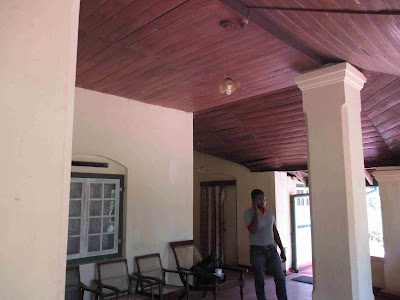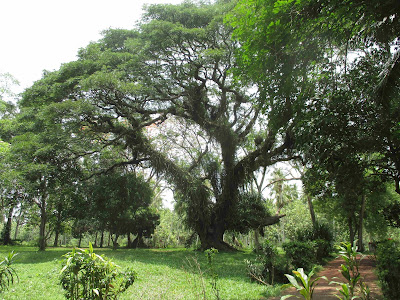According to information provided by Mrs. Maggie Pulle, our grandfather C.S. Braine, who worked for Ceylon Tea Plantations Co, served at the following estates. She found this in the Fergusons Directory, which listed info about planters and estates in Ceylon.
1898 East Holyrood, Talawakele (tea) -Age 24 years
1904 Mawatta (coconut) - 30 years
1909 Yakvilla, also spelt Yakwila (coconut) - 35 years
1912 Yakvilla - 38 years
1914 Mawatta - 40 years
So C.S. Braine, our grandpa, began as a tea planter and then was moved to coconut plantations by his employer, Ceylon Tea Plantations Company. From 1914, he appears to have been at Mawatte till falling ill in the early 1940s. He passed away in 1944.
So C.S. Braine, our grandpa, began as a tea planter and then was moved to coconut plantations by his employer, Ceylon Tea Plantations Company. From 1914, he appears to have been at Mawatte till falling ill in the early 1940s. He passed away in 1944.
His employer appears to have moved him between Mawatte and Yakvilla, a distance of 15 miles. He must have met grandmother Engracia Nonis when he was at Mawatte between 1904 and 1908, because their first child Rosie was born in 1909. Quite unlikely that he would have taken her and the children to Yakwila (not done those days, and they only married in 1924, anyway).
My sister and I visited Yakwila on April 6 and were happy to see that the estate, under the Livestock Development Board, still has the same acreage as 100 years ago, and is maintained in good condition. "A green and pleasant land", and I understand why Mr. Herbert Brett, father of Aunt Edith, named his house in the UK after this estate (Brett appears to have been the manager during 1906/07.) Sri Lanka nationalized large land holdings in the 1970s, and an individual was allowed to keep only 50 acres. But, because Yakwila (and Siringapatha) were taken over from Ceylon Tea Plantations Co., the estates were only nationalized, not split up.
The bungalow at Yakwila is on a low hill. Only the roof has been changed, from tin sheets to tiles. But, it has not been well maintained; this has happened at most nationalized plantations. The interior is dark (even the wooden ceiling needs repairs and a coat of paint), is in bad shape, and not well lit. The garden is neglected.
The European planters, whether on tea, rubber or coconut estates, kept their bungalows impeccably. The surrounding gardens were colorful with flowers. Every bungalow had a kitchen garden. The Ceylonese (local) lads who came into planting were trained by the Europeans for years (they were said to be "creeping") and did a good job of keeping up with tradition. But, at estates like Yakwila, run by a state organization, there is little concern for tradition. The current manager, who is friendly and enthusiastic, has no experience in planting or in coconut. He grew up near Kandy, got a BSc in agriculture, and was suddenly put in charge of 300+ acres of land. He received no training. The job must be a challenge, because he also has problems in finding labourers, as the Livestock Board doesn't pay well, and workers are leaving for better paying jobs. Yakwila has only 10 labourers, wheres about 30+ are needed. Coconut plantations cannot be mechanized.
Siringaptha, a larger estate, may have been the center of a string of surrounding plantations. For instance, on the signboard, Yakwila is named a "division" of Siringaptha plantation. The bungalows at Siringapatha are better maintained, perhaps because a regional manager of the Livestock Board usually resides in the old, grand bungalow, and the resident manager also has a family. He is interested in tradition and has compiled a list of past managers going back to the 1930s, and it's displayed in his office. I told him about the Fergusons Directory, so he should be able to complete his list soon.
 |
| NLDB stands for National Livestock Development Board |
 |
| Yakwila bungalow |






5 comments:
Wow.. thanks for mentioning about this estate and especially about me.. time has gone bit and I hope now it is the high time for you to visit here again. Now the farm has been changed a lot and the old bungalow was renovated well.
Oh my gosh it's so great to see all these pics and your stories, thank you so much. Siringapathe is a huge memory of my family's upbringing. Our father was a manager there for many years until we left for Australia in 1973. My Dad met my mum in the early 50's and brought her there, where she fell in love with Siringapathe, but I'm not sure how long he was there beforehand, I think it was some years. I have pics of those fun parties and times on that verandah. Currently in my lounge room graces a huge sketch of the estate from a pic taken when we left, it's very special to my family. Thank you Teddy for this blog, it tugged at my heart so much.
And I've got a really clear memory of that verandah on Yakvilla as a child- around 1970-2 - going there with my father. An incident occurred while I was there, so that's why I remember it so well. So great to also see those photos of Yakvilla- it matched my memory so well and it's the only picture I've seen. Thanks again. Great job on your blog! You're helping others with their precious memories of the estate.
Hello Suzy,
I just read your comments. Thanks. I am trying to have the two estates listed on the History of Ceylon Tea website. Andigama is already there. If you could do a write-up about Siringapatha and Yakwila, I'll try to have them posted on the site, too.
georgebraineatgmail.com
Post a Comment